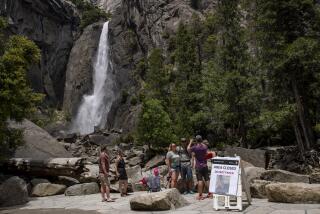Grand Canyon Considers Banning Cars, Using Trams to Ease Parking Nightmare
GRAND CANYON NATIONAL PARK, Ariz. — The principle is simple: A family vacation should not degenerate into an exhaust-shrouded battle to park at the edge of one of the world’s greatest natural wonders.
But that is precisely what is happening at the Grand Canyon, and officials are looking for solutions--even a ban on cars.
“The Grand Canyon experience is rapidly approaching that of a bad day at a shoddy shopping mall,” said Roger Clark, a spokesman for the Grand Canyon Trust, an advocacy group. “You can easily spend an hour and a half of a two-hour visit just looking for a place to park.”
On a typical summer day, about 20,000 visitors pass through the gates of Grand Canyon National Park, most of them in the more than 6,000 cars that jam the roads and compete for fewer than 2,000 parking spaces.
West Rim Drive, which hugs the lip of the mile-deep canyon and gives access to numerous overlooks and trail heads, already is closed to cars in the summer. Visitors instead ride a free tram.
There are no limits on cars elsewhere in the park--yet.
“We anticipate the day when . . . there won’t be any automobiles inside the Grand Canyon National Park,” Interior Secretary Bruce Babbitt told a gathering sponsored by the Grand Canyon Trust in October.
Brad Traver, the Grand Canyon’s chief of professional services, said replacing cars with mass transit is but one of a number of options being studied as part of a $1.5-million planning process begun in 1991.
Among other possibilities: closing some of the lodging in the park, or requiring future construction--including housing for park employees and visitor services--to be in communities outside the park boundary.
Another proposal would require visitors to get permits, much like the system already uses for backcountry hiking. Traver said this would help spread visitors over a broader area and control crowding during peak periods.
“That doesn’t necessarily mean people would be turned away,” Traver said. “They might be asked to return later in the day or something like that.”
As it is now, almost all visitors to the 227-mile-long park funnel onto about 30 miles of scenic roads along the canyon’s south rim. The main visitor center, Grand Canyon Village, is a maze of narrow roads serving the headquarters, hotels, restaurants, shops and campgrounds.
Babbitt, a former Arizona governor who has hiked extensively in the park, favors building “gateway villages” outside its boundaries where people would leave their cars, continuing by foot, horseback or mass transit.
In his private law practice, Babbitt had represented a developer who plans to build just such a village outside the park gates in Tusayan.
Interior Department spokesman Kevin Sweeney said Babbitt won’t take part in any decisions involving the developer, Canyon Forest Village Corp. And he said Babbitt supported gateway villages long before he worked for Canyon Forest.
Tusayan--including motels, an airport, restaurants and a big-screen theater that perpetually plays a canyon travelogue--is about seven miles south of the main park entrance. Otherwise, the closest sizable cities are Williams and Flagstaff, 50 and 80 miles away, respectively.
Traver said there was broad support during a series of public hearings in October and November for eliminating cars from Grand Canyon Village. But he said there was no consensus for a complete ban on vehicles in the park.
Czeslaw Schmidt, an Arizona retiree, went to the park on his honeymoon 45 years ago and visits regularly--most recently last June.
Traffic, he said, has become a headache.
“There’s lines to get into the park that went about 10 minutes,” Schmidt said. “At the visitor center there was no place to park. Wh had to park maybe half a mile away in a campground and walk.”
Last summer, he used the West Rim Drive tram and liked it, except for the half-hour wait to board the bus. But he isn’t sure others are so agreeable.
“Europeans would probably prefer the bus, the Japanese probably too,” Schmidt said. “Americans would probably rather use their car.”
More to Read
Sign up for The Wild
We’ll help you find the best places to hike, bike and run, as well as the perfect silent spots for meditation and yoga.
You may occasionally receive promotional content from the Los Angeles Times.






